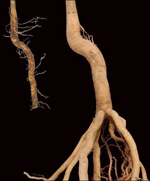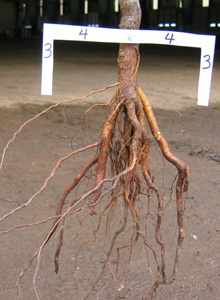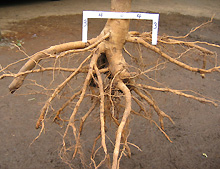Home > Nursery tree production > Root system > Propagating quality liners > Growing quality liner root systems in field
Growing quality liner root systems in the field
Many nursery trees produced in field soil are propagated with seeds planted directly into nursery soil, or with trees planted from containers. A year or more later trees may be moved to a different field depending on the nursery. Seeds planted directly into field soil typically develop a tap root (right photo). There may or may not be lateral branch roots growing from the tap root. Many trees develop only a few lateral branch roots; some trees develop no lateral branch roots at this stage of their life.

Tap root is pruned so trees can be moved easily to other fields as trees grow larger (left photo, Dr. Gary Watson). Following root pruning (left side of photo) new roots typically grow down at an angle from just behind the cut surface of the pruned tap root forming an adventitious flare one year later (right side of photo). A close look at the photo of the two trees shows that none of the small lateral roots present behind the pruned tap root grew into permanent roots. The 4-7 inch long portion of the tree above the adventitious root flare is root tissue (called the root shank), not trunk tissue. It might look as if the grower planted the tree too deeply. Some trees, especially riparian species such as sycamore, can develop lateral roots from the root shank. 
Two years later, root systems can look like the root system shown at right (photo courtesy Keith Warren). This root form may be poorly adapted to certain compacted soil types, and may have to develop a much shallower root system after planting in order to thrive in the landscape. We need more research on this. Some trees form a root system with both shallow roots and deep roots like the tree shown below (photo courtesy Keith Warren). Trees with this root form may adapt quicker to soils typical of many urban landscapes since some main roots are close to the surface where oxygen is more prevalent. The soil level on both trees is indicated by the horizontal white plastic piece with the number "4" on it.
 Production techniques are available to force more roots laterally so fewer grow down (see previous page). These focus on germinating seeds or growing cuttings in containers that force some roots laterally when trees are very young. Setting the root system early in a more lateral orientation could lead to a root system more adapted to urban soils. Testing is just beginning (see two photos below) but shows promise to encourage at least some horizontal lateral roots, even on genera such as Quercus and Taxodium which typically produce primarily deep roots early in their life.
Production techniques are available to force more roots laterally so fewer grow down (see previous page). These focus on germinating seeds or growing cuttings in containers that force some roots laterally when trees are very young. Setting the root system early in a more lateral orientation could lead to a root system more adapted to urban soils. Testing is just beginning (see two photos below) but shows promise to encourage at least some horizontal lateral roots, even on genera such as Quercus and Taxodium which typically produce primarily deep roots early in their life.
Two examples (mahogany left, baldcypress right) below of liner root systems with ample lateral roots produced by growing in a container with sides and bottom comprised of 90% air and 10% plastic. This liner root system may produce a finished nursery tree well adapted to urban soils due to amply lateral root growth. Testing is underway (April 2010).
|
|



